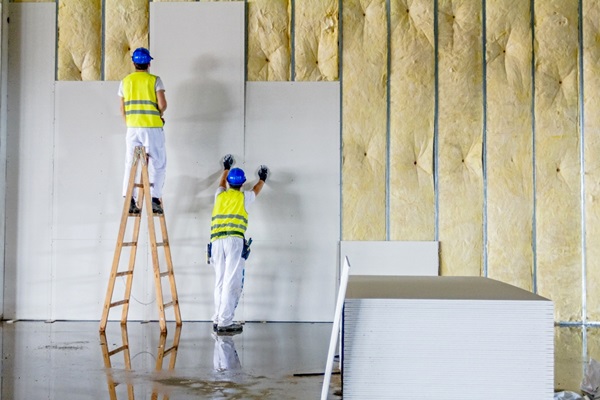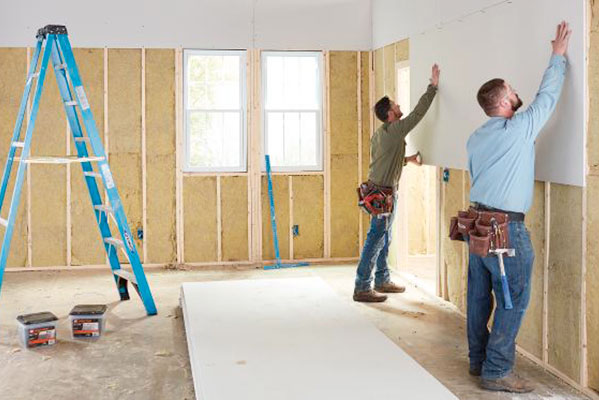Premier Drywall Fort Worth Services for Residential Projects
Premier Drywall Fort Worth Services for Residential Projects
Blog Article
Complete Guide to Reliable and efficient Drywall Installment
Drywall setup is an essential component of any building and construction or renovation job, requiring a careful technique to ensure both effectiveness and reliability. It is necessary to explore the nuances of each step in the procedure, as they jointly contribute to the overall success of the drywall installment.
Necessary Tools for Drywalling
When embarking on a drywall setup project, having the right devices is essential for attaining an expert surface. Vital tools include a drywall knife, measuring tape, and a T-square, which are essential for precise measurements and smooth cuts. A drywall lift is likewise very beneficial, particularly for ceiling setups, enabling less complicated handling of heavy panels.
For attaching the drywall, a cordless drill and drywall screws are essential. The drill needs to be furnished with a drywall little bit to ensure performance and accuracy. In addition, a vital tool is the drywall saw, which helps with reducing about various other barriers and electrical outlets.

Moreover, protective equipment such as shatterproof glass and a dust mask are vital to guarantee personal safety and security during the installation procedure. Using the right tools not just enhances the high quality of the installment but also simplifies the workflow, making the task a lot more effective overall.
Preparing the Room

Following, analyze the condition of the walls and ceilings. Fix any existing damage, such as holes, cracks, or peeling paint, to ensure a smooth and also surface for drywall application. Additionally, check for electric outlets, plumbing lines, and cooling and heating ducts, noting their areas to stay clear of difficulties throughout setup.
It is also important to measure the room accurately, determining the measurements of the wall surfaces and ceilings to calculate the ideal amount of drywall needed. Create a detailed plan that includes the layout and orientation of the drywall panels.
Installation Methods
Effective setup strategies are crucial for accomplishing a professional coating in drywall jobs. Correct measurement and cutting of drywall sheets are fundamental actions. Always gauge the wall space precisely, enabling any type of outlets or switches. Utilize an energy knife for tidy cuts, scoring the paper face and breaking the board along the racked up line.
When hanging drywall, begin with the leading and work downward, guaranteeing that the lengthy side of the board is vertical to the framework. Secure the sheets with screws instead of nails, which offer better holding power and minimize the danger of standing out. Location screws every 12 inches along the sides and every 16 inches in the field of the board.
For edges, utilize corner beads to achieve sharp, clean edges. When setting up on ceilings, use a drywall lift or have a partner help in holding the sheets in position (drywall installation). Keep a space of regarding 1/4 inch above the flooring and ceiling to fit expansion and tightening
Completing Touches

Begin by applying joint tape over the seams. This can be either paper or fiberglass his response fit together tape, with paper being favored for its toughness. As soon as the tape is in area, it's time to apply you could look here the first coat of joint compound, likewise called mud. Use a 10 to 12-inch taping blade to spread the substance uniformly over the taped joints, feathering the sides to mix with the bordering drywall.
Allow the compound to completely dry thoroughly, typically 24-hour. After drying out, sand the surface area gently with fine-grit sandpaper to get rid of any type of flaws. drywall contractor. Repeat the mudding and sanding procedure, usually 2 to 3 layers, making certain each layer is smooth and flush with the drywall surface area
Usual Mistakes to Stay Clear Of
Numerous do it yourself lovers come across challenges during drywall installment that can endanger the outcomes. One typical error is falling short to effectively cut and determine drywall sheets. Unreliable cuts can bring about voids and uneven joints, making completing more labor-intensive. In addition, overlooking to startle joints can develop weak points in the wall surface, resulting in possible drooping or breaking gradually.
One more constant error is inappropriate fastening. Making use of also couple of screws or nails can result in loose drywall, while overdriving bolts can trigger the paper to tear, damaging the structure. It's essential to keep constant spacing, generally every 16 inches, and to make certain that fasteners are flush with the surface area.
Moreover, not dealing with dampness issues prior to setup can result in mold and mildew development and architectural damages. Always examine the environment and usage moisture-resistant drywall in high-humidity areas.
Final Thought
Reliable and reliable drywall installment calls for careful attention to detail throughout the process. By using important tools, preparing the space properly, and adhering to best methods in installation methods, a flawless finish can be achieved. In addition, careful application of joint substance and tape throughout the ending up phase enhances durability and appearance. Avoiding common errors even more adds to a professional outcome, underscoring the relevance of precision and strategy in successful drywall jobs.
It is crucial to explore the subtleties of each step in the procedure, as they jointly contribute to the general success of the drywall installment.When getting started on a drywall installment company website project, having the right tools is essential for accomplishing a professional finish.For fastening the drywall, a cordless drill and drywall screws are needed.Appropriately preparing the space is vital for a successful drywall installment.Reliable setup techniques are vital for achieving a specialist surface in drywall tasks.
Report this page